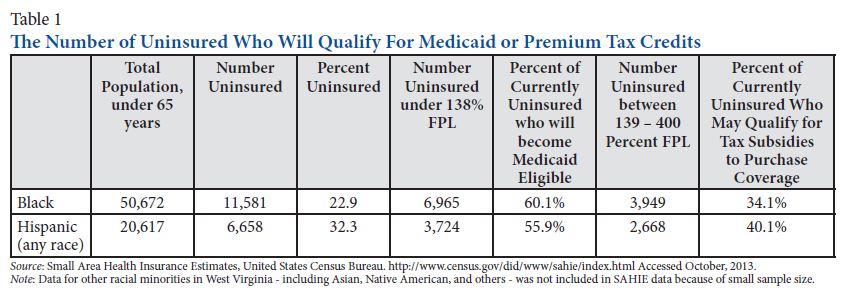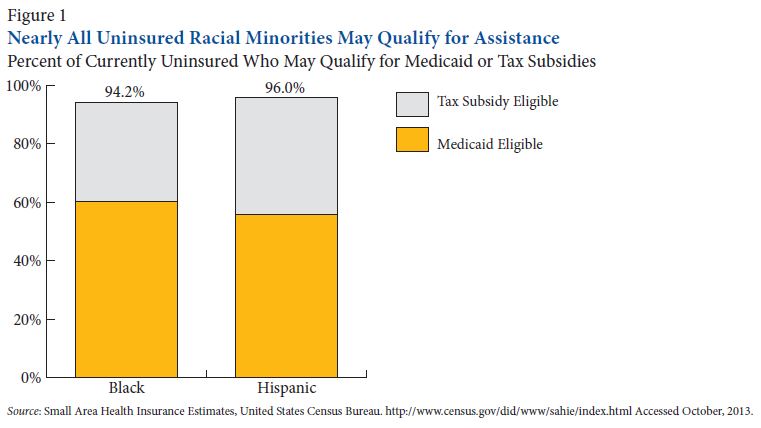The Affordable Care Act is expected to have a dramatic impact on access to health insurance in West Virginia. This will be especially true for racial and ethnic minorities. Even though the minority population in West Virginia is relatively small compared to other states, it is 50 percent more likely to lack health insurance than whites in West Virginia. According to the most recent data from the U.S. Census Small Area Health Insurance Estimates, around 23 percent of blacks and 32 percent of Hispanics* under the age of 65 lack health coverage in West Virginia. By comparison, less than 18 percent of the white population under age 65 is uninsured. Read PDF of report.
This, along with other social and economic disparities, helps explain why racial minorities experience disproportionately worse health. For example, African Americans suffer from higher rates of diabetes, heart disease, infant mortality and low birth weight than whites. It is therefore no surprise that life expectancy for African Americans who live in West Virginia is 2.6 years less than whites.
The good news is that the Patient Protection and Affordable Care Act (ACA) should help reduce these disparities by expanding health insurance significantly beginning in 2014.
The ACA, signed into law in 2010, includes a number of provisions designed to improve the quality of health insurance and increase access to coverage. Reducing the share of uninsured Americans will be primarily achieved in two ways – by expanding who is eligible for Medicaid, and by creating a health insurance exchange where individuals who do not have insurance through their employer can purchase an affordable plan.
Currently, Medicaid coverage is reserved for specific low-income groups such as children, pregnant women, the elderly, the blind or disabled, and parents who are in extreme poverty (below 35% of Federal Poverty Level (FPL) or $6,335 for a family of three). This means that childless adults between the ages of 19 and 64 do not qualify and very few low-income parents qualify for Medicaid. Under the ACA, however, Medicaid eligibility will expand to include anyone living in a household below 138 percent of the FPL, about $15,860 for an individual or $32,500 for a family of four in 2013.
This new eligibility level, which begins on January 1, 2014, will mean that a large portion of the currently uninsured minorities in West Virginia will become eligible. In fact, Medicaid expansion alone could cut the number of uninsured minorities in the Mountain State by more than half. Three out of five uninsured blacks in West Virginia will be eligible for Medicaid while more than half of Hispanics in the state will become Medicaid eligible (Table 1).

In addition to Medicaid expansion, the health insurance exchange, called the Marketplace, is expected to increase health insurance coverage across the state for those not eligible for Medicaid. A person or family who does not have access to health insurance through an employer will be able to purchase a plan on the Marketplace and will likely qualify for federal tax subsidies to help reduce the monthly premium, possibly helping to cover co-pays and deductibles as well.
The federal subsidies will be available for those who do not qualify for Medicaid yet earn less than 400 percent of the FPL, about $45,960 for an individual or $94,200 for a family of four. The amount of the subsidy available to an individual or family is determined by its total modified adjusted gross income, or MAGI, with the subsidy decreasing as income nears 400 percent of FPL.
In West Virginia, around 34 percent of uninsured blacks and 40 percent of uninsured Hispanics fall into this range and would possibly qualify for some level of tax subsidy in the Marketplace.
Putting these two components together shows that around 95 percent of uninsured African Americans and Hispanics may qualify for assistance in accessing health coverage in West Virginia as a result of the ACA (Figure 1).
The ACA ensures that every insurance plan will offer a minimum of coverage that includes preventive care such as annual checkups and immunizations, maternity care, and emergency services. It guarantees that people will not be denied health insurance due to a previous illness, and it forbids insurance companies from setting annual or lifetime limits on the amount of care a person may receive.
The ACA also lays the groundwork to dramatically reduce the uninsured rates of racial minorities throughout the state, while essentially eliminating the disparity between whites and racial minorities.
There are many aspects that contribute to someone’s health status. These “social determinants of health” include measures like income, education level, employment, and location. While the ACA does not and cannot address all of these factors, it nevertheless provides an unprecedented opportunity to improve health and well-being, both physical and financial, by assuring tens of thousands of uninsured minority West Virginians get affordable access to health care.
The ACA can have a huge impact on reducing the rate of uninsured minorities in West Virginia, however, it is important to recognize that it will not happen on its own. Surveys have consistently found that the people who are most likely to benefit from the ACA are often unlikely to know it. Therefore, coordinated and widespread outreach is imperative to guarantee that these groups are made aware of the assistance that may be available to them and are given the help and resources they need to get enrolled.
West Virginia also must recognize and step up to its role in this process and ensure that minority groups are targeted in the ACA rollout. The state received significant funding from the federal government to train In-Person Assisters (IPAs) to help enroll people across the state. To date, West Virginia has funded only about 200 of the 270 IPA positions that were initially indicated, none of whom are specifically designated to assist with minority enrollment.
This effort to close the gap and reduce the number of uninsured racial minorities in West Virginia should not be delayed as the end of the open enrollment period is just around the corner.

* The U.S. Census Bureau race data are based on self-identification. People who identify their origin as Hispanic or Latino may be of any race.
Small Area Health Insurance Estimates (SAHIE), U.S. Census Bureau https://www.census.gov/did/www/sahie/index.html Accessed October, 2013.
The average life expectancy at birth in 2010 for whites was 75.4 years compared to 72.8 years for African-Americans. Infant mortality rates are 11.6 deaths per 1,000 live births for African-Americans compared to 7.5 deaths per 1,000 live births for whites. Fifteen (15.0) percent of all African-American births were low birth weight versus 9.0 percent of white births. Diabetes deaths per 100,000 population was 64.9 for blacks and 32.2 for whites. All of this data is found at the Kaiser Family Foundation, “State Health Facts” http://kff.org/state-category/health-status/ Accessed October, 2013.
“Summary of the Affordable Care Act.” Kaiser Family Foundation. April 2013. http://kff.org/health-reform/fact-sheet/summary-of-new-health-reform-law/
Eligibility determination for Medicaid and the Advanced Premium Tax Credits (APTC) in the Marketplace will be based on MAGI, not total gross income. The amount of the subsidy an individual or family receives is determined based on their income, household size, and the cost of the insurance plan.
The Robert Wood Johnson Foundation and the Urban Institute released “Eligibility for Assistance and Projected Changes of Coverage under the ACA: Variation Across States” in October of 2013 and projected that 81 percent of the currently uninsured in West Virginia would qualify for Medicaid or subsidies under the ACA. The RWJF/UI report used an in-house simulation to model Modified Adjusted Gross Income (MAGI), assistance eligibility, and uptake rate by state using 3-year American Community Survey (ACS) data from the US Census Bureau, while the data from this report was generated using the US Census Bureau’s Small Area Health Insurances Estimates which utilizes ACS data among other Census datasets to estimate health insurance coverage rates.
A population survey completed by the West Virginia University School of Public Health – http://publichealth.hsc.wvu.edu/hrc/News/2013/November/Population-Survey-Results-of-the-Evaulation-of-the#sthash.ASAelLtu.U7uDf77j.dpbs – found that nearly 75 percent of uninsured survey respondents did not know about the health insurance Marketplace while almost 85 percent of the uninsured did not know that financial assistance may be available to them. Similar results were found by the Kaiser Health Tracking Poll, September 2013. http://kff.org/health-reform/poll-finding/kaiser-health-tracking-poll-september-2013/